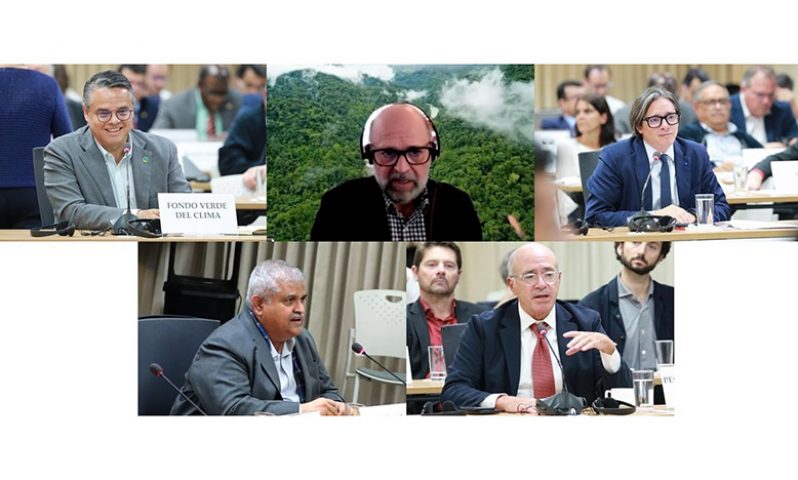AT a meeting in Costa Rica, agriculture ministers and high-level officials of more than 30 countries of the Americas listened to presentations by representatives of multilateral credit organisations and global financing funds, who gave details on opportunities for the development of projects on climate-change mitigation and adaptation in agriculture.
The session was part of a meeting organised by the Inter-American Institute for Cooperation on Agriculture (IICA) in San Jose, Costa Rica, with a view to enabling the region’s agricultural sector to develop a joint position to take to the upcoming United Nations Climate Change Conference (COP27), which will be held in Egypt in November.
Henry González, Deputy Executive Director of the Green Climate Fund (GCF), gave details on how the largest multilateral climate change fund operates.
González explained that the GCF was established under the United Nations Framework Convention on Climate Change and was recognised as one of the funding mechanisms of the Paris Agreement.
Specifically, he explained that, “We support developing countries to transition towards low emission and climate-resilient economies. We go where the private sector cannot go and have adopted a high-risk and long-term vision.” He also indicated that, “IICA is one of the entities most recently accredited to access GCF projects.”
González revealed that the GCF has already funded projects to the tune of $10.8 billion, but has managed to mobilise approximately $30 billion from other entities, bringing the total value of its portfolio to $40.2 billion.
“The fund represents approximately two to three per cent of total climate change funding in the world. Approximately 49 per cent of our projects are for adaptation and 51 per cent for mitigation. Thus, we are extremely close to achieving our objective of creating a balance between the two.”
The official also indicated that the organisation has funded 70 agriculture-related projects, valued at $1.1 billion, focusing on issues such as agro-ecology, the reduction of methane in rice, resilient and low-emission livestock production and the reduction of losses due to food waste.
CROSS-CUTTING
Carlos Manuel Rodríguez, CEO and Chairperson of the Global Environment Facility (GEF), commended IICA on organising the meeting to discuss the position of the agricultural sector of the Americas, in view of COP27, stressing that: “The environment is a cross-cutting issue today and is not the exclusive property of ministers of the environment.”
Rodríguez revealed that the GEF, which was established at the Rio de Janeiro Earth Summit in 1992, has channelled $121 billion in funding over the last 30 years, benefitting 163 developing countries.
“The problems of climate change and lost biodiversity are two sides of the same coin, because both are a product of a model based on irrational consumption that aspires to limited growth, with no knowledge of planetary limitations,” said Rodríguez, who was the Costa Rican Minister of the Environment on three occasions.
“Although our work has concentrated primarily on ministries of the environment, GEF funds are available to ministries of agriculture.
“Sometimes I ask myself what is the difference between ministries of agriculture and the environment. I think we have transcended that dichotomy, because production and conservation are not in competition. The ministries of agriculture are working with domesticated biodiversity and the environmental ministries with wild biodiversity, both with the same economic and social actors and the same landscapes,” he said.
Christian Asinelli, Corporate Vice-President of Strategic Programming at the CAF-Development Bank of Latin America, indicated that a recent shareholder meeting of the regional financial institution had approved, by consensus, a$7 billion increase in capital – the largest in its history.
GREEN BANK
He maintained that, “We want to be the green bank of Latin America, with 40 per cent of our projects focusing on climate change-related issues, and also to be the economic recovery bank.”
Asinelli stated that, in view of the fact that all countries in the region had committed to reducing their greenhouse gas emissions, CAF had developed an initiative to create a Latin American carbon market, in which the agricultural sector would play a leading role, as it could move from being a net emitter to being a net sink that captures the gases that produce climate change.
“We are talking a great deal about the environment and climate, but we are doing too little. We need to wake up to the reality of the climate-change challenge. No one is coming to save us; we have to save ourselves, with imagination and innovation,” said Satya Tripathi, Secretary-General of the Global Alliance for a Sustainable Planet.
Tripathi referred to the central issue that countries are appealing for private funding for climate action.
“Don’t fool yourselves. One billion dollars is not available every year for climate change. The money is not going to come,” he said in reference to the amount that the developed countries had committed to under the Paris Agreement.”
Thus, he felt that, “Working with the private sector and developing respectful partnerships could produce outstanding results.” (IICA)




.jpg)











